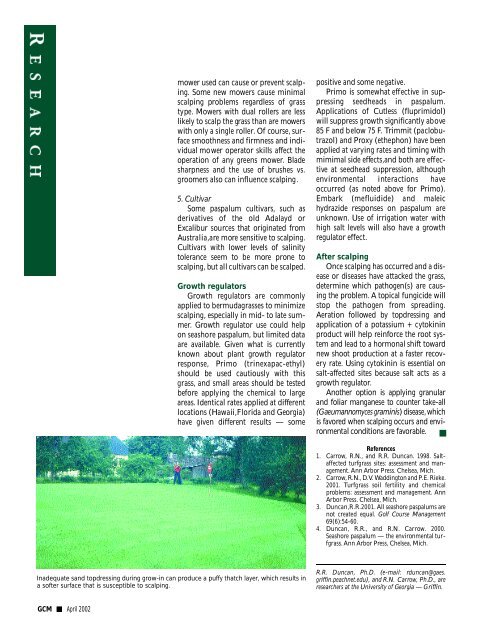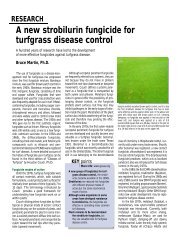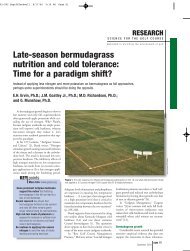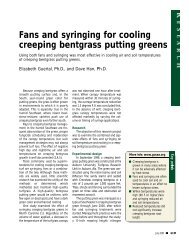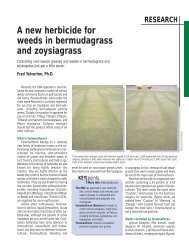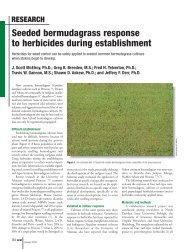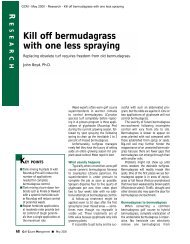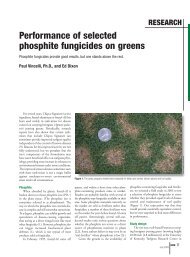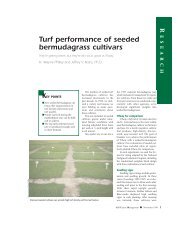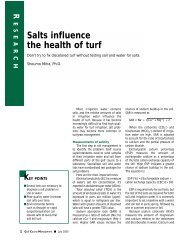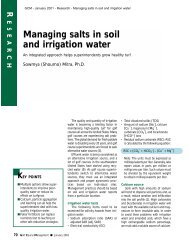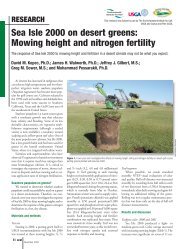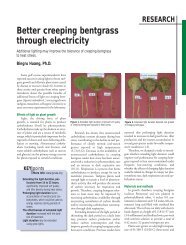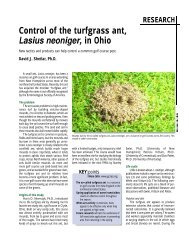Thou shalt not scalp seashore paspalum - GCSAA
Thou shalt not scalp seashore paspalum - GCSAA
Thou shalt not scalp seashore paspalum - GCSAA
You also want an ePaper? Increase the reach of your titles
YUMPU automatically turns print PDFs into web optimized ePapers that Google loves.
mower used can cause or prevent <strong>scalp</strong>ing.<br />
Some new mowers cause minimal<br />
<strong>scalp</strong>ing problems regardless of grass<br />
type. Mowers with dual rollers are less<br />
likely to <strong>scalp</strong> the grass than are mowers<br />
with only a single roller. Of course, surface<br />
smoothness and firmness and individual<br />
mower operator skills affect the<br />
operation of any greens mower. Blade<br />
sharpness and the use of brushes vs.<br />
groomers also can influence <strong>scalp</strong>ing.<br />
5. Cultivar<br />
Some <strong>paspalum</strong> cultiva rs , su ch as<br />
deriva tives of the old Ad a l ayd or<br />
Exc a l i bur sources that ori gi n a ted from<br />
Au s tra l i a ,a re more sen s i tive to <strong>scalp</strong>ing.<br />
Cu l tiva rs with lower levels of s a l i n i ty<br />
to l era n ce seem to be more prone to<br />
s c a l p i n g, but all cultiva rs can be <strong>scalp</strong>ed .<br />
Growth regulators<br />
Growth reg u l a tors are com m on ly<br />
applied to bermudagrasses to minimize<br />
<strong>scalp</strong>ing, especially in mid- to late summer.<br />
Growth regulator use could help<br />
on <strong>seashore</strong> <strong>paspalum</strong>, but limited data<br />
are available. Given what is currently<br />
known about plant growth regulator<br />
re s pon s e , Primo (tri n ex a p ac - et hyl )<br />
should be used cauti o u s ly with this<br />
grass, and small areas should be tested<br />
before applying the chemical to large<br />
areas. Identical rates applied at different<br />
locations (Hawaii,Florida and Georgia)<br />
have given different results — some<br />
positive and some negative.<br />
Primo is somewhat effective in suppressing<br />
seed h e ads in paspalu m .<br />
App l i c a ti ons of Cutless (flu pri m i do l )<br />
will suppress growth significantly above<br />
85 F and below 75 F. Trimmit (paclobutrazol)<br />
and Proxy (ethephon) have been<br />
applied at varying rates and timing with<br />
mimimal side effects,and both are effective<br />
at seedhead suppression, although<br />
envi ron m ental interacti ons have<br />
occurred (as <strong>not</strong>ed above for Primo).<br />
E m b a rk (mef lu i d i de) and malei c<br />
hydrazide responses on <strong>paspalum</strong> are<br />
unknown. Use of irrigation water with<br />
high salt levels will also have a growth<br />
regulator effect.<br />
After <strong>scalp</strong>ing<br />
O n ce <strong>scalp</strong>ing has occ u rred and a disease<br />
or diseases have attacked the gra s s ,<br />
determine wh i ch pathogen(s) are causing<br />
the probl em . A topical fungi c i de wi ll<br />
s top the pathogen from spre ad i n g.<br />
Aera ti on fo ll owed by top d ressing and<br />
a pp l i c a ti on of a po t a s s ium + cyto k i n i n<br />
produ ct wi ll help rei n force the root system<br />
and lead to a horm onal shift tow a rd<br />
n ew shoot produ cti on at a faster recovery<br />
ra te . Using cytokinin is essen tial on<br />
s a l t - a f fected sites because salt acts as a<br />
growth reg u l a tor.<br />
An o t h er opti on is app lying gra nu l a r<br />
and foliar manganese to co u n ter take - a ll<br />
( Ga eu m a n n o myces gra m i n i s) disease,wh i ch<br />
is favored wh en <strong>scalp</strong>ing occ u rs and environ<br />
m ental con d i ti ons are favora bl e. ■<br />
References<br />
1. Carrow, R.N., and R.R. Duncan. 1998. Saltaffected<br />
turfgrass sites: assessment and management.<br />
Ann Arbor Press. Chelsea, Mich.<br />
2. Carrow, R.N., D.V. Waddington and P.E. Rieke.<br />
2 0 0 1 . Tu rfgrass soil ferti l i ty and ch em i c a l<br />
problems: assessment and management. Ann<br />
Arbor Press. Chelsea, Mich.<br />
3. Duncan,R.R.2001. All <strong>seashore</strong> <strong>paspalum</strong>s are<br />
<strong>not</strong> created equal. Golf Course Management<br />
69(6):54-60.<br />
4. Du n c a n , R . R . , and R.N. Ca rrow. 2 0 0 0 .<br />
Seashore <strong>paspalum</strong> — the environmental turfgrass.<br />
Ann Arbor Press, Chelsea, Mich.<br />
Inadequate sand topdressing during grow-in can produce a puffy thatch layer, which results in<br />
a softer surface that is susceptible to <strong>scalp</strong>ing.<br />
R . R . Du n c a n , Ph . D. (e-mail: rdu n c a n @ ga e s .<br />
griffin.peachnet.edu), and R.N. Carrow, Ph.D., are<br />
researchers at the University of Georgia — Griffin.<br />
GCM April 2002


